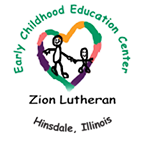Reggio Emilia
Zion's Reggio Approach to Early Childhood Education
In 1991, the schools of Reggio Emilia, Italy, received international attention when they were selected by Newsweek magazine as "the best early childhood institute in the world." After careful consideration, Zion incorporated the Reggio approach in the design of the curriculum and the classrooms for the ECEC, which opened in the fall of 2005. The curriculum builds upon the interests of the children. Projects are in-depth explorations of topics that are motivated by young children's excitement and curiosity. Exploration is done through observation, experimentation, books, and technology. Children represent their chosen topic through the languages of music, drama, story, construction, sculpture, paint and drawing. The teachers observe and record the children's questions and conversations.
Each class in Zion's ECEC is staffed with two teachers. However, in the Reggio approach, the environment is considered the "third teacher." The classroom is set up to inspire, nurture and encourage discovery. It is arranged purposely to provide opportunities for learning. The outside playground offers additional spaces for explorations. These include a workbench, a sand area, picnic tables, climbing equipment, water tables, an art area with easel, a playhouse and a shaded deck. This allows the teachers to take into account the developmental characteristics and learning style of each child. Children are encouraged to collaborate, communicate, negotiate, hypothesize, problem-solve and critique as they work in small groups. Teachers are researchers with the children, as they guide, lend their expertise, and document the children's learning. Follow the links below to see examples of ECEC Reggio projects:
-
From our 2-yr-olds
-
From our 2½-yr-olds
-
From our 3-yr-olds
-
From our 4-yr-olds


